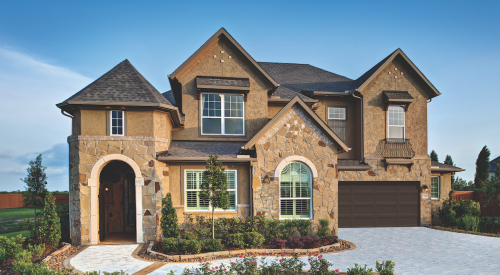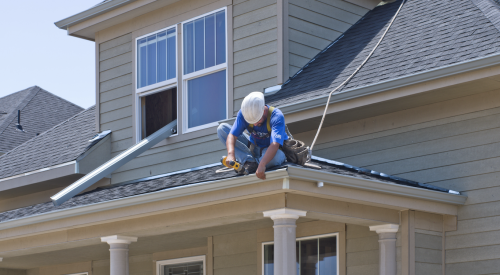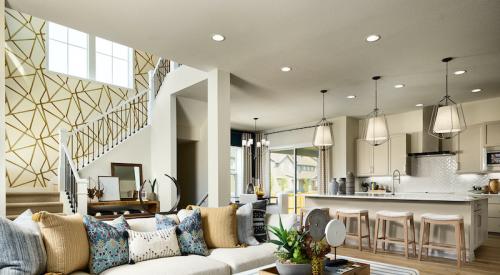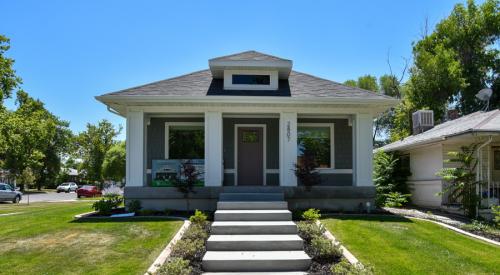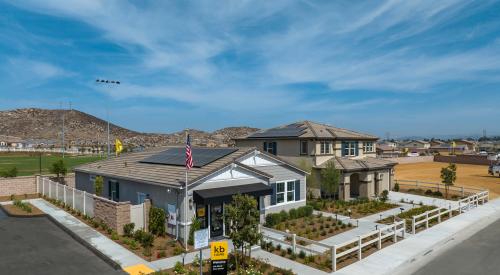 |
| Homes in Clarum Homes’ 257-unit Vista Montaña community (above) in Watsonville, Calif., use roof-mounted solar panels from AstroPower to produce much of their own energy. Clarum’s first all-ZEH community, 20-home Shorebreeze in East Palo Alto, Calif. (below), use roof-integrated power systems that blend seamlessly with the flat concrete tile roofs. Roof-integrated systems for barrel tile roofs, such as the ones in Vista Montaña, do not exist. |
More than a dozen projects are finished or in the works, from single homes to entire communities of Zero Energy Homes. Tim Merrigan, senior program director at the NREL, says the ultimate goal is to produce buildings by 2020 that manufacture all of their own energy.
Paying It Forward
ZEH homes connect to and can use energy from the standard utility grid but also produce energy through renewable means, usually solar panels, or photovoltaics. Net metering allows the electric meter to spin backward and forward, meaning at times the home pulls (and pays for) power from the grid and at others it produces more energy than it needs, with the excess sold to the electric company. Utilities in 36 states offer net metering, and several states offer rebates and other incentives.
In partnership with private industry, the Florida Solar Energy Center built a prototype ZEH in 1998 in Lakeland, Fla. In side-by-side testing, the prototype outperformed a conventional home by consuming far less energy, and it also met 85% of its electrical demands on site. Performance testing is just finishing for a Loudon County, Tenn., ZEH home built by the local Habitat for Humanity chapter, the Structural Insulated Panel Association and other private and public entities, including the Tennessee Valley Authority, the largest public utility in the nation. That home garnered a Home Energy Ratings System score of 90.2 out of 100, significantly above the 80 prescribed by the International Energy Conservation Code and the 86 that Energy Star requires. Fifty monitors in the home track energy consumption, which cost 85 cents per day for the first 10 months. Two subsequent homes built by the consortium rated 93.3 and 93.9 in HERS testing.
For-profit builders are taking the ZEH plunge, too. Tucson, Ariz., home builder John Wesley Miller and the NAHB Re-search Center team have begun NREL-funded performance testing on an all-electric home that Miller hopes will produce a net-zero energy bill for its inhabitants, who moved in Oct. 1. He sold the 1,700-square-foot home for $386,000 within a month of its opening. Special partnerships and donations for the prototype home lowered product and design costs, but Miller says he can replicate the design and sell ZEH homes for the same amount while still hitting his margins.
At the largest ZEH endeavor in the nation, Vista Montaña in Watsonville, Calif., Clarum Homes offers the Enviro-Home — the company’s name for its ZEH product — as standard in all 257 single-family homes and townhomes, which range in price from $370,000 to $525,000. Key features include photovoltaic panels; tankless, on-demand water heaters; radiant roof barriers; low-E windows; and a foam-wrapped, super-tight building envelope.
Clarum vice president John Suppes says buyers receive a $20,000 added value to their homes, which are designed to cut energy bills by up to 90%. Clarum re-coups a lot of the cost through a contract with photovoltaic manufacturer Astro-Power that grants the builder volume-based discounts and through a California Energy Commission rebate of more than $4 a watt or 50% of the solar power system’s total cost, whichever is greater.
Despite the momentum and continuing successes, the future of the NREL’s ZEH program remains unclear. As of mid-October, the DOE had not provided a fiscal 2004 budget for the program, but Merrigan says he’s optimistic that the final federal budget will fund further research and performance testing.
|
The ZEH Advantage
Zero Energy Homes have a number of advantages for homeowners:
Source: U.S. Department of Energy |
|
What Goes Into a ZEH?
Zero Energy Homes combine thoughtful design with innovative building techniques and materials to optimize a variety of features:
Source: U.S. Department of Energy |
